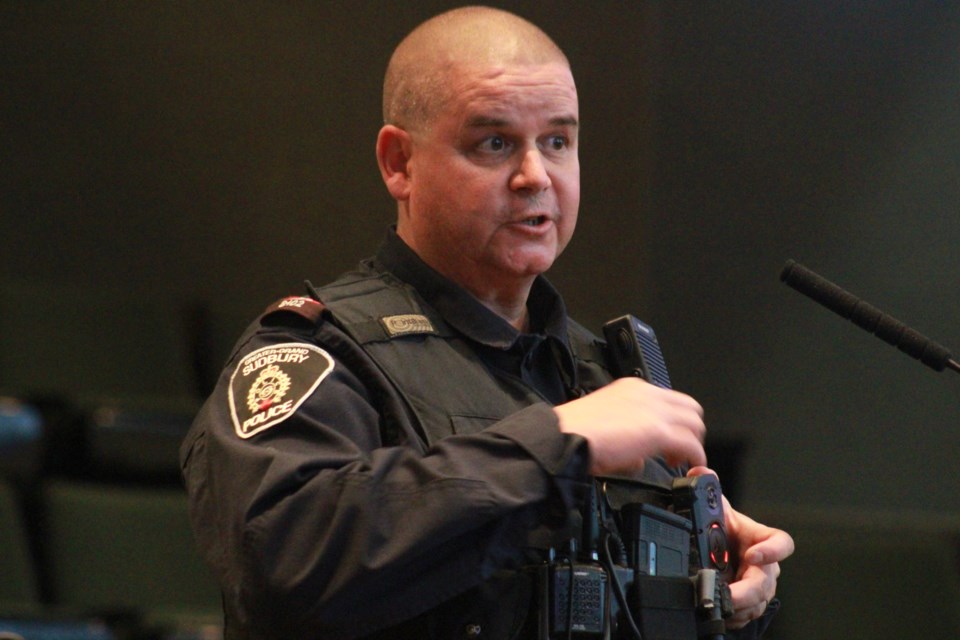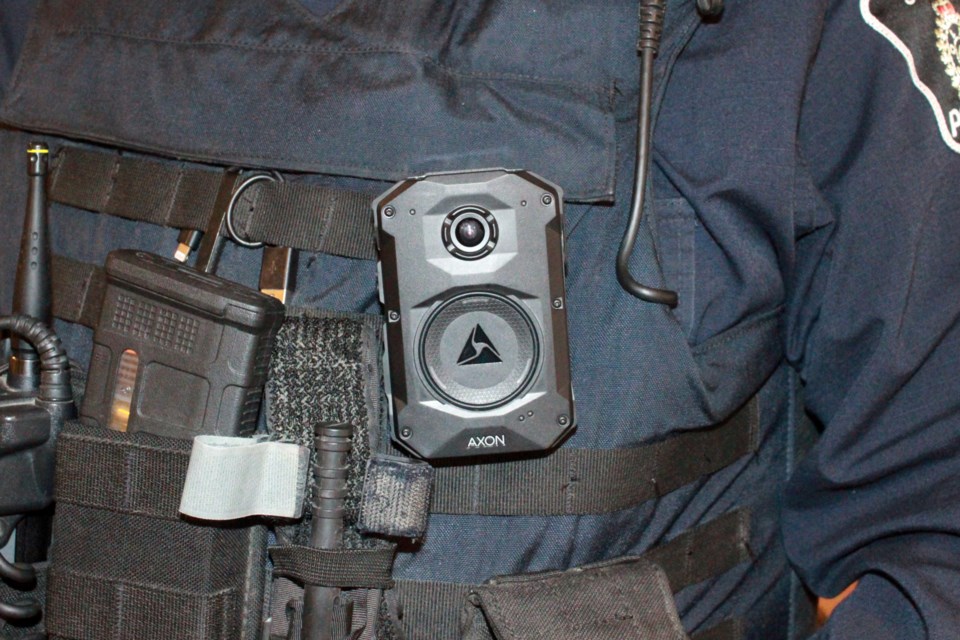Most public interactions between Greater Sudbury police officers and members of the public will be captured via body-worn cameras when they’re fully rolled out by approximately 2026.
“With a few exceptions, when officers are engaged with members of the public there’s an expectation that the cameras would be on,” Insp. Marc Brunette told Sudbury.com.
“The camera will show both sides, so you have a third witness to every call,” Const. Marc Savignac told the police board during Wednesday’s meeting at Tom Davies Square.
“This is a tool, and it’s clear what the purpose is, it’s to build trust in the community.”

Savignac wore one of Greater Sudbury Police Service’s first body-worn cameras during the meeting. The cameras were recently procured as part of the first phase of a broader rollout at the end of which all 170 frontline officers will wear the devices throughout their shifts.
The first phase will kick off in January, when 30 members in GSPS’s emergency response and traffic enforcement units will begin wearing the chest-mounted cameras, following training next month.
Brunette told Sudbury.com that it’s premature to say when they’ll continue to the second phase, consisting of full deployment of body-worn cameras, but that it’d likely take place by early 2026.
Wednesday’s presentation by Savignac helped explain why police are adopting body-worn cameras, as well as when and how they will be used.
The camera being used is the Axon Body 4, which is the Arizona-headquartered company's latest version.
They were a sole-source acquisition, Chief Sara Cunningham explained, because of their ability to link with other pieces of police equipment which allows them to automatically switch and begin recording whenever a firearm or conducted energy weapon is unclipped.
The camera’s field of view is 160 degrees, with a battery life of 14 hours, recording up to 128 gigabytes of video of doorbell-camera resolution, which Savignac said is enough to remain in operation for an entire shift.
Not that they’ll be recording at all times, the constable clarified.
They’re intended to record public interactions between police and civilians.
Police officers will be expected to let people know they’re being recorded as quickly as possible, and to ask permission when they’re in a private residence, hospital or school. Whereas members of the public can decline to be filmed in private residences in certain cases, GSPS policy dictates that all public interactions must be filmed.
Exceptions to the ability of people to deny filming in private settings are when a search warrant is being acted upon and when officers are responding to an active incident of alleged criminality.
Officers will be expected to turn on cameras to record interactions. In some cases, Brunette said interactions might commence quickly and police might not activate their camera.

In cases where firearms or conducted energy weapons are unclipped, a sensor is tripped and all body-worn cameras within a radius of approximately 30 feet automatically turn on.
Camera data will be loaded into the police database as soon as each shift ends, and a team behind the scenes will be responsible for filing the information and readying it for use. When used as evidence, certain things such as children’s faces might need to be blurred out, while certain audio, such as identifying comments, may have to be removed.
As for accessing the data itself, Savignac said that anyone who views the video will be digitally flagged, and that anyone who views video without the authority to do so would be in trouble.
“This is not to embarrass anyone,” he said of the video captured. “This is to capture evidence.”
In addition to internal viewing by GSPS members, video access can be granted via the Municipal Freedom of Information and Protection of Privacy Act, an authorized complaint resolution process, through the courts and released to the public by the chief of police when there’s a “compelling public interest.”
“I wish we had these years and years ago,” Savignac told the board. “It shows the truth of what’s going on, even though different people have different angles and perspectives and sobriety. … It’s going to record the good and the bad and the in between."
Not only do body-worn cameras offer a layer of transparency for the public, but he said they might also protect officers against frivolous complaints.
“When people see themselves on video and how they’re reacting that day and at that time, and where sobriety is influenced … they will have a different perspective when they see the video.”
Body-worn cameras are becoming commonplace among police services, with the RCMP announcing last week that they’re deploying more than 10,000 cameras across the country within the next 18 months.
The Greater Sudbury Police Board approved a budget allocation for body-worn cameras in early 2021, and entered into an agreement with Axon Public Safety Canada Inc. for a rollout initially planned for late 2022.
Significant work was required on the back end to prepare for the data dump they produce, with next year’s phase-in with an initial 30 cameras anticipated to work out kinks before a full rollout.
Tyler Clarke covers city hall and political affairs for Sudbury.com.
